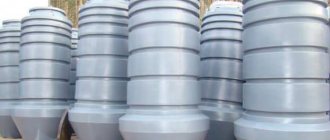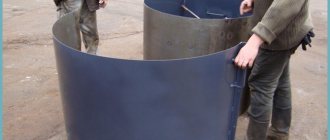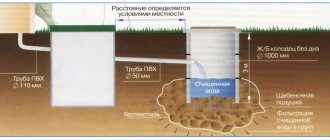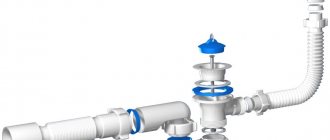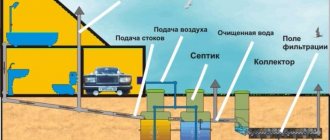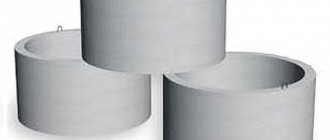Any owner of a private house or cottage, where there is no centralized water supply, has more than once thought about installing a well. And someone has even encountered similar work. And the main difficulty here is not even to dig a well, but to equip it. Some line it inside with bricks, others purchase and install concrete rings. But recently, products that are designed to make such work easier are gaining more and more popularity. These are plastic well rings that have less weight compared to concrete ones, and at the same time greater strength. That's what we'll talk about today.
Plastic wells are quite common today
Reinforced concrete is quite difficult to install due to the large weight of the products
Classification methods: types and sizes
Plastic rings are used in arranging communications of all types. Therefore, if we take into account the scope of application, we can select products for a well (drinking water), for a septic tank or sewerage system. It is convenient to divide products according to the material from which they are made; in this case the following options are possible:
- Made from polyethylene. The main advantages of plastic are its long service life and indifference to significant temperature fluctuations (from -50 to +70°C), which allows its use in most climate zones. Polyethylene rings have a multilayer structure, which increases their strength and resistance to aggressive environments; installation does not require special skills and knowledge.
- Made from polypropylene. Durable and resistant to abrasion, polypropylene plastic rings can withstand temperatures up to +120-140°C without changing their performance properties. Polypropylene is a chemically resistant material that is not afraid of aggressive organics; To increase frost resistance, stabilizing additives are introduced into its composition.
Rings and additional elements Source montagtrub.ru
- Made from fiberglass. Fiberglass, which is part of the polymer, gives the products particularly high wear resistance. They are not subject to corrosion, are durable, do not break down when working in aggressive environments, and are safe to maintain since they do not conduct electricity. The main disadvantage is the high cost.
The dimensions of plastic structures are standardized as follows:
- Inner diameter (with and without bottom): 60, 68, 80, 90 cm.
- Outer diameter: 65, 73, 85, 95 cm.
- The height varies depending on the type of product (stacked or solid), from 20 to 150 cm.
- The lid is selected according to the size of the neck. The internal diameter varies from 55 to 90 cm, the external diameter - from 60 to 95 cm.
Benefits of use
The use of plastic in the installation of communications simplifies the progress of work and subsequent operation due to its improved physical and chemical characteristics. The advantage of polymer rings for wells is expressed in the following advantages:
- Improved physical properties. Plastic, unlike ring concrete, does not require maintenance or repair. The design maintains original performance characteristics over a wide range of operating temperatures.
Comparison of the characteristics of plastic and reinforced concrete Source seti.guru
- Inertness The polymer is resistant to any organic and inorganic substances contained in water and soil, as well as to most technical compounds (chemicals, oils).
- Improved wear resistance. Plastic retains its strength for 45-50 years of service.
- You can refuse additional waterproofing. You will not have to spend additional time and money, as is the case with a concrete structure that needs to be treated with waterproofing compounds. To ensure that the system does not allow water to pass through, it is necessary to follow the installation technology.
- Light weight. A standard concrete ring weighs about 600 kg, while a plastic ring weighs less than 50 kg. Transportation and installation are greatly simplified.
- Environmentally friendly. Modern polymer materials are completely safe for health. Due to their inertness, they do not emit harmful substances under any operating conditions.
The drainage well protects the adjacent area from flooding Source novoe-mesto.ru
The only thing in which plastic products are inferior to their concrete counterparts is cost. However, the owners who made the choice in favor of plastic were convinced that it was completely justified, since it eliminated many problems during the operation of the products:
- They do not need to be cleaned, since the smooth walls do not form plaque suitable for the development of microorganisms.
- They maintain good tightness and are not afraid of soil movements.
- They are not afraid of periodic freezing and thawing.
- If necessary, they can be equipped with additional accessories, for example, a hatch, a ladder, a neck.
See also: Catalog of companies that specialize in water supply, sewerage and related work
What is the service life
If we compare composite material with reinforced concrete products, the latter has a limitation of 50 years. If reinforced concrete does not completely collapse during this period, it will lose its operational properties. Also, every year you will have to check the tightness of all joints and the entire structure as a whole.
As for polymer rings, they will not lose their positive properties throughout their entire service life. According to forecasts, such structures will last for centuries. However, this will be possible provided that installation technology and proper maintenance are followed.
Functionality and scope
The main way of using polymer products in the private sector is in wells for drinking water. Another area of use is drainage and sewer systems, and in private households - a septic tank.
The bottom is made of the same material as the body Source seti.guru
Plastic rings intended for sewerage can be divided according to purpose into the following types:
- Observations. Without them, normal functioning of sewer pipelines is impossible. With their help, they carry out maintenance, monitor the condition of the system, and deliver equipment. They are installed at places of rotation, connection, change in slope or diameter.
- Absorbent. They are needed where it is impossible to drain wastewater, for example, in private septic tanks. Drainage material (crushed stone, broken brick, gravel) is poured into their bottom.
- Water intakes. The accumulated water is diverted somewhere else: into a drainage system, into an open reservoir or ditch. For water intake wells, it is important to have a sealed plastic cover. It helps to avoid sewer overflow when water comes in quickly (for example, after heavy rain).
When there is no central main line nearby, an autonomous sewer system can be built without the use of a septic tank. To do this, the bottom of the well, mounted from plastic rings, is supplemented with a kineta - a special tray with pipe connection points. The system will allow waste to be discharged evenly.
A well for sewerage, next to it is the bottom (sink) Source ytimg.com
With the help of plastic well rings it is convenient to restore dilapidated structures, concrete, brick, earthen. To update the source, just select rings with a smaller diameter and install them in one of the following ways. The space between the old and new walls is filled with sand.
Summary
Compared to alternative technical solutions intended for the construction and reconstruction of wells, septic tanks and other hydraulic structures, the products look decent, practical and economically profitable. This is achieved thanks to the following advantages:
- the sizes of plastic rings, inserts and additional elements ensure high-quality and unhindered restoration of wells built on the basis of standard reinforced concrete rings;
- for the restoration of old wooden log houses (Finnish wells), the manufacturer’s assortment includes plastic inserts and rings of reduced diameter;
- All products are made from safe and durable materials that meet the requirements of sanitary and environmental standards (linear polyethylene and HDPE 100).
Simplicity and high quality of assembly are ensured by the design features of plastic rings, wells and inserts: threads cut in production conditions, as well as the presence of special socket connections guarantee the strength, tightness and durability of quickly assembled connections.
Construction and details
By design, polymer wells are divided into the following types:
- Prefabricated. They are assembled directly at the installation site using the groove connection principle. Prefabricated products are lightweight and can be installed alone.
- Monolithic (seamless). A convenient option for arranging a drinking well. The polymer pipe is immersed inside the aquifer; it is sealed enough to protect the water from contamination.
- Welded. Made from polyethylene, used for sewerage.
- Any plastic well, regardless of the material of manufacture, includes the same set of parts:
- Bottom. Durable and thick cast part. The bottom can be blind, through or tray (the latter has guides for diverting the flow).
Construction of a sealed plastic well Source oboiman.ru
- Well (chamber). The main element is in the form of a smooth or corrugated pipe of large diameter with thick walls.
- Hatches, covers. Appearance depends on the purpose. The blind hatch prevents debris, groundwater and sediment from entering the well shaft. Lattice models are used in combination with storm drainage systems.
- Ring. Designed to regulate the height of the polymer well.
- Caisson. It is used to create a waterproof working chamber in water-saturated soil or to protect the well from contamination.
- Accessories. Necks (most often present on inspection wells), reinforced steps for wells.
There are more specialized varieties. For example, a well for a well has a relatively small body diameter. Additionally, it is equipped with corrugations that help to effectively withstand soil pressure; Stiffening ribs also help with stability.
The neck is an essential part of many products Source oboiman.ru
Installation of drains, why such a system is needed
The development of human society presupposes the improvement of living conditions. People have long since left the caves and realized that living in a house with all the amenities is much more comfortable. But for it to become this way, a lot of effort will have to be made, and one of the main conditions is the installation of a local sewerage system or cesspool.
Previously, it was a well with brick walls and an earthen bottom so that liquid waste was absorbed into the ground. But such a design is unacceptable today. It can lead to an environmental disaster. Someone will try to object. You will say that everyone used to do this before and the question of how to properly put together a toilet in the country was not raised. But then such a large amount of water and various detergents and cleaning chemicals were not used. And cesspools were built only for street toilets.
Let's watch the video, a little about septic tanks and wastewater systems:
A modern local sewage system involves draining water from washing machines and dishwashers, after taking a bath and shower - all of which involve the use of chemicals that are not harmless to the environment. That is why a cesspool today is a whole list of conditions, without which its construction is unacceptable. We will look at them below.
How to restore a well with plastic rings
Plastic well rings are rarely used for self-installation. With their help, concrete structures that have lost their tightness due to long-term use and wear, broken installation technology, or soil pressure that has caused displacement of parts are brought back to life. The occurrence of a problem is judged by the following signs:
- Damages or defects in a shaft that are visible to the naked eye.
- A sharp decrease in water level (unless this is due to seasonal changes or, for example, to a deeper mine dug in the neighborhood).
- The water became cloudy and a foreign smell appeared.
- The bottom silts up, impurities appear (sand, clay, soil), cleaning does not help.
The operation of the well can be restored using polymer rings. Repair work is carried out in the following order:
- The well frame (ground part) is dismantled.
- The water is pumped out using a pump.
- If necessary, the walls of the well are disinfected.
- Remove debris, sand, and silt from the bottom.
Composite blank for a well Source seti.guru
Restoration begins three days after preparation, for which the following actions are performed:
- Plastic rings are connected into a single structure. If the bottom surface is not smooth enough, it is first updated by adding sand, crushed stone or broken brick.
- Additionally, the seams can be treated with a sealant (for example, silicone).
- The space formed between the plastic and the soil is filled with sand.
- After completing the work, wait until the well fills on its own. Then install a drainage pump and pump out the water several times until it becomes clear.
A backfill is made between the plastic and the soil. Source ytimg.com
How to make the right choice
When choosing polymer rings for a sewer or drinking well, you must be guided by the following criteria:
- The price of polymer products depends on the type and quality of the material, wall thickness, dimensions and design features (for example, the number of pipes).
Different types of drainage wells Source colodec.ru
- Monolithic and prefabricated models are offered on the market; the latter are more expensive.
- A monolithic body cannot be used in all cases. It is durable, withstands compression well, but is only suitable for shallow mines, and it is impossible to build it up.
- A well of any height can be made from prefabricated products; at the junction of individual elements there is a sealing ring responsible for the tightness. In general, the design is more flexible than a monolithic one, but the more connections there are, the greater the likelihood of leaks.
- Models with pipes save time: you don’t have to cut in the pipes yourself.
Installation of a caisson for a well Source proraboff.rf
Price
The price tag for polymer products will differ depending on the features and technology of creation, as well as the manufacturer itself. The final cost is affected by diameter, height, wall thickness, etc. Plus, each element of a prefabricated well will have an individual cost. Approximate prices are shown in the table below:
| View | Characteristics | Price thousand rubles |
| Ready well “Yenisei” Height 2 meters | Thickness 50 mm and outer diameter 110 cm | 14,5 |
| Ready well “Yenisei” Height 3 meters | Thickness 50 mm and diameter 110 cm | 21.3 |
| Polymer ring | Height 20 cm and diameter 100 cm | 1700 |
| Ring with cap | Diameter 80, height 30, neck diameter 75 cm | 29 |
Important! There may be a different manufacturer in your area, and therefore the price will be different. Therefore, it is better to compare several manufacturers before purchasing.
Briefly about the main thing
Plastic rings simplify the construction of a drinking well; they eliminate the need to install concrete rings or line the internal walls with bricks. The materials used are plastics with different properties; some are extremely resistant to aggressive environments, others tolerate negative temperatures well.
In the private sector, plastic structures are most often used for the restoration of drinking wells, installation of wells and sewage systems. They can be prefabricated, welded and seamless, differ in size and the presence of additional elements.
Ratings 0
Installation of plastic rings for technical wells
The process of installing a plastic sewer well or a well for any other purpose is not much different from that described. The difference can only be when installed on soils prone to heaving. In this case, there is a possibility that the container will be pushed upward. To avoid this, plastic rings for the well are secured. The most commonly used term is “anchoring”, and the process of pushing out is called “floating”.
One of the options
The traditional solution is to dig a pit a little deeper than required and make a gravel or sand-gravel cushion at the bottom. An “anchor” - a concrete slab - can be placed on this pillow. This can be a ready-made stove or a homemade one. The dimensions are larger than the bottom of the well. The slab must have hooks or “ears” to which plastic rings are attached with cables (stainless or polymer). Then the gap between the walls of the dug hole and the well is filled up. For heaving soils, it is better to use medium or coarse gravel rather than “native” soil.
